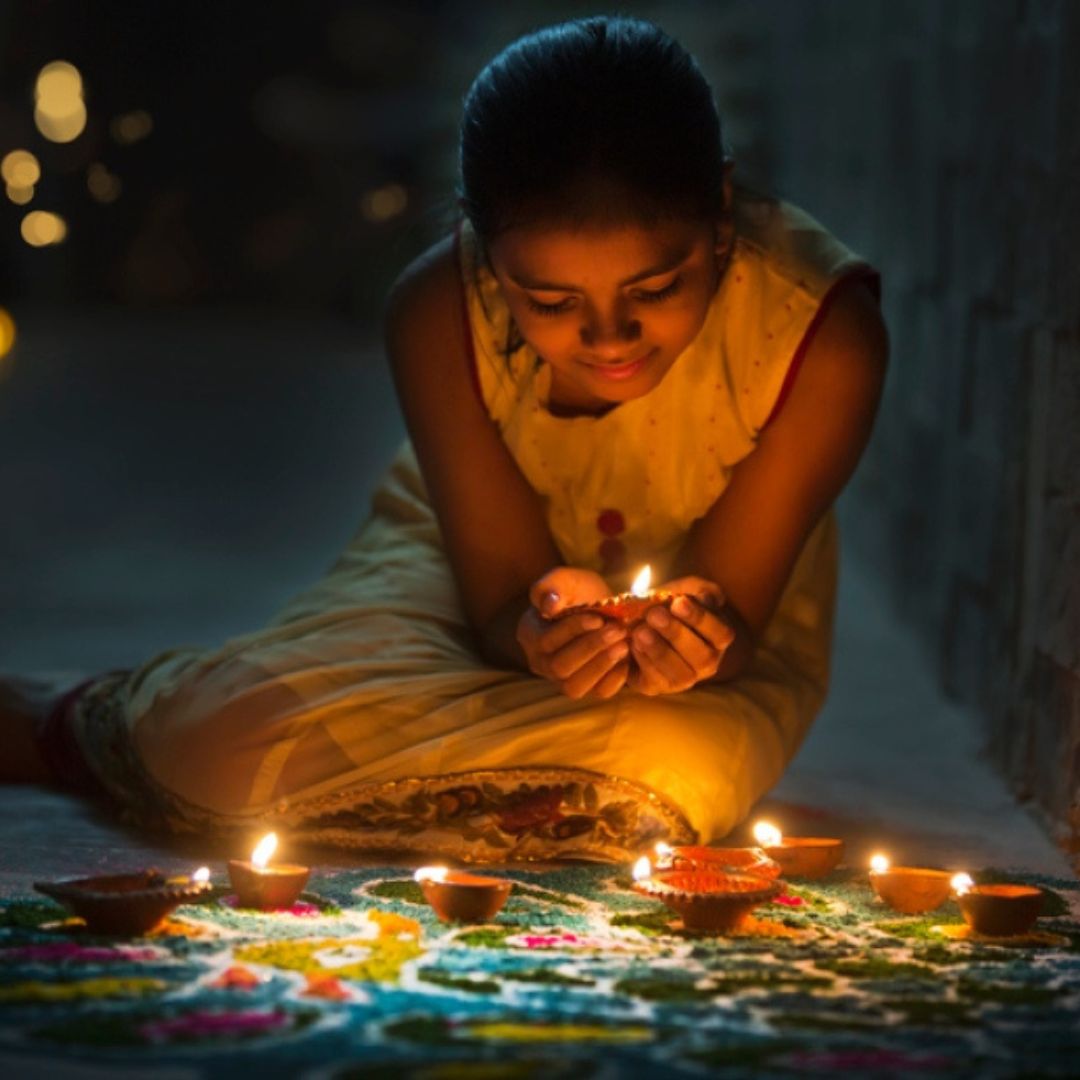The Festival of Lights has many legends and lore associated with it. There is no single story behind the origin of this festival. Even though there are many stories and historical narratives behind this festival, they all ultimately represent the victory of good over evil.
Also checkout, Everything You Need to Know About Diwali and Its Celebration Across India
The Return Of Lord Rama To Ayodhya
The most commonly associated story with the celebration of this festival, especially in north and west India, is from the Hindu epic Ramayana. According to Hindu mythology, Diwali is celebrated on the day Lord Rama, his wife Sita, and brother Lakshmana returned to their home in Ayodhya after 14 years in exile and after defeating the evil king Ravana.
When Rama, Sita, and Lakshman returned from Lanka at night, villagers lit rows of oil lamps along the streets to guide them home. These lamps are known as diyas or divas. Through this, the festival of Diwali was born. To this day, people celebrate Diwali by lighting diyas or candles in their homes – a true festival of light.

The Birth Of Goddess Lakshmi
Many people honour the Hindu goddess of wealth, Lakshmi during Diwali. The lights and lamps are said to help Goddess Lakshmi find her way into peoples’ homes, bringing prosperity in the coming year! The story goes that Goddess Lakshmi was provoked by God Indra to leave the divine world and enter the Milky Ocean. Without her, the world turned dark. After churning the milky ocean for 1,000 years, Goddess Lakshmi was reborn and once again brought her blessings of good fortune. Many people believe that Diwali is the celebration that marks Lakshmi’s wedding with Vishnu.

The Victory Of God Krishna
In south India, Diwali commemorates the victory of the god Krishna over the demon king Narakasura. Once the demon was killed, Lord Krishna called for a day of festivities. This day of festivity is called Naraka Chaturdashi and is celebrated the day before Diwali. Some regions of India burn effigies of the demon to celebrate Diwali.

The Story Of Mahavir’s Enlightenment
In Jainism, Diwali commemorates the anniversary of Lord Mahavir’s attainment of moksha, or freedom from the cycle of reincarnation, in 527 BC. Lord Mahavir was the 24th and last Thirtankar of Jainism (spiritual leader). First referred to in Jain scriptures as dipalikaya or light leaving the body, Jains believe that the Earth and the heavens were illuminated with lamps to mark the occasion of Lord Mahavir’s enlightenment. Jain’s light lamps on Diwali to symbolise keeping the light of Lord Mahavir’s knowledge alive and sweets are also distributed.

Bandi Chhor Diwas
For Sikhs, Diwali is significant because it celebrates the release from prison of the sixth guru, Guru Hargobind, and 52 other princes with him, in 1619. Guru Hargobind Sahib Ji was being held by the Mughal Emperor Jahangir with 52 princes. Sikhs call Diwali as Bandi Chhor Diwas, meaning the day of liberation.
Sikhs celebrated the return of Guru Hargobind by lighting the Golden Temple in Amritsar with diyas and this tradition continues today.

Kali Puja
People living in the Indian states of West Bengal and Assam celebrate Diwali as Kali Puja. Goddess Kali is worshipped. People believe that she destroys all evil. Lamps are lit in her honour, and in return, she promises a renewal of life and justice on earth.

The Legend Of Bali
The powerful King Bali ruled over the netherworld, Earth, and heavens. All the gods feared him so much that they sent Lord Vishnu to get rid of him. Lord Vishnu took the form of a dwarf and appeared before Bali. He asked him that he be granted control of all the land which he could cover in 3 paces. Because of the dwarf’s small stature, Bali granted this request, and it was then that Vishnu grew to enormous proportions, covered all Bali’s kingdom in two paces, and with the third pace stomped him down into the netherworld. However, Vishnu granted Bali the right to return to earth for one day each year, and it is thus that Bali is celebrated during Diwali alongside other legendary figures.

The End Of The Pandava’s Exile
The Mahabharata is an ancient Indian epic. When the five Pandava brothers returned to their kingdom from their exile it was on the dark and moonless night of Kartika Amavasya. To celebrate their return the people of their kingdom lit innumerable earthen lamps to welcome them home. Later, lighting earthen lamps also became a vital part of celebrating Diwali. The 5 Pandavas, namely – Yudhishthira, Bhima, Ariuna, Nakula, and Sahadeva, had lost everything they had in a game of dice (gambling) playing against Kauravas. When they were left with nothing to bet, they were punished with 12 years of exile. During these 12 years, Pandavas lived in hardship.

Watch full video on, A Cultural Journey Across India | Diwali Traditions and Festivities

